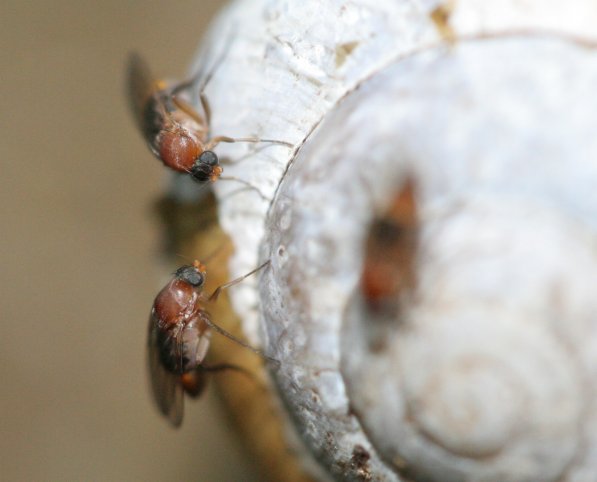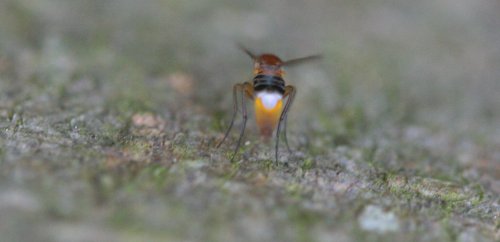I will be writing a short paper adding this species to the British fauna, and describing my observations, but Diptera.info seems to be the perfect place to post a series of photographs which will be too costly to publish in a journal!
The swarms consisted of twenty to thirty females flying between 0.2 and 1 metres above the ground, and within 0.2 metres of the trunk. When undisturbed, up to ten females would settle on the tree trunk, in a ?head-down? posture, eaching one staying like this for up to a minute before settling elsewhere or joining the swarm again. In the ?head-down? posture, the flies extend the abdomen and point it torwards the tree, exposing the membranous patch at the base of the fifth tergite
This photo shows the 'display posture' of a Phalacrotophora delageae female.
 |
The unchitinised part of the tergite appears to glow brightly. It contrasts with the black tergites 2 to 4 in front and the orange of the remainder of the fifth segment.
 |
If the overall brightness is digitally reduced, you can see how much this little fly appears to glow in the dark! I did examine some live specimens in the dark, and under an ultra-violet lamp, but there was no evidence of luminescence or enhanced reflection with UV.
 |
While sitting in this pose, the females vibrate their wings, presumably creating a distinctive sound. Visually this appears to be exactly the same as the wing-waving of Drosophila when it is 'singing'. This sequence shows the position of the wings at different points in the 'song'.
 |
After a while, the females stop their display and sit on projections on the tree trunk (in this case a snail shell) where they interact in a casual way. Then they join the swarm again before landing in the display posture for another session.
 |
I did not see any males at the swarming sites, and could not find any concentrations of coccinellid larvae or pupae close by. So the purpose of these female Phalacrotophora swarms is still a bit of a mystery, but I think that the visually striking display posture, combined with the 'song' and possibly pheromones must be to attract a mate.
After all, to a male Phalacrotophora this female can only be saying 'Come and get me!'
 |













 but don't see the image in the post.
but don't see the image in the post.

Am I wrong, but did you never said that was a glowing fly?
I only read that she?s bright but not bioluminescent...
Am i correct? But I would really like to see a glowing one.
I never saw a glowing diptera here. Maybe someday who knows.